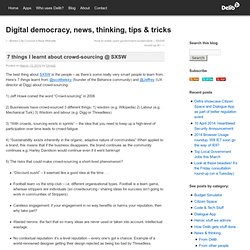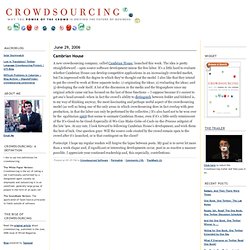

7 things I learnt about crowd-sourcing @ SXSW. The best thing about SXSW is the people – as there’s some really very smart people to learn from.

Here’s 7 things learnt from @scottbelsky (founder of the Behance community) and @Jeffrey (UX director at Digg) about crowd-sourcing: 1) Jeff Howe coined the word “Crowd-sourcing” in 2006 2) Businesses have crowd-sourced 3 different things: 1) wisdom (e.g. Wikipedia) 2) Labour (e.g. Mechanical Turk) 3) Wisdom and labour (e.g. 3) “With crowds, sourcing exists in sprints” – the idea that you need to keep up a high-level of participation over time leads to crowd-fatigue 4) “Sustainability exists inherently in the organic, adaptive nature of communities” When applied to a brand, this means that if the business disappears, the brand continues as the community continues e.g. 5) The risks that could make crowd-sourcing a short-lived phenomenon?
“Discount sushi” – it seemed like a good idea at the time . . .Football team vs the strip club – i.e. different organisational types. Crowdsourced Software. A new crowdsourcing company, called Cambrian House, launched this week.

The idea is pretty straightforward – open source software development minus the free labor. It's a little hard to evaluate whether Cambrian House can develop competitive applications in an increasingly crowded market, but I'm impressed with the degree to which they've thought out the model. I also like that they intend to put the crowd to work at three separate tasks: 1) originating the ideas; 2) evaluating the ideas; and 3) developing the code itself. Postscript: I hope my regular readers will forgive the lapse between posts. My goal is to never let more than a week elapse and, if significant or interesting developments occur, post in as reactive a manner possible. Wired 14.06: The Rise of Crowdsourcing.
Remember outsourcing?

Sending jobs to India and China is so 2003. The new pool of cheap labor: everyday people using their spare cycles to create content, solve problems, even do corporate R & D. By Jeff HowePage 1 of 4 next » 1. The Professional Story Tools Story Images Click thumbnails for full-size image: Claudia Menashe needed pictures of sick people. In October 2004, she ran across a stock photo collection by Mark Harmel, a freelance photographer living in Manhattan Beach, California.
The National Health Museum has grand plans to occupy a spot on the National Mall in Washington by 2012, but for now it’s a fledgling institution with little money. After several weeks of back-and-forth, Menashe emailed Harmel to say that, regretfully, the deal was off. iStockphoto, which grew out of a free image-sharing exchange used by a group of graphic designers, had undercut Harmel by more than 99 percent. He can’t, of course. It took a while for Harmel to recognize what was happening. Top 10 Crowdsourcing Companies. There is a lot of buzz going on around “crowdsourcing” lately, a term coined by the Wired journalist Jeff Howe is his article “The Rise of the Crowdsourcing”.

The first time I googled (lower case g because it is already recognized as a verb by the Webster dictionary) “crowdsourcing” it generated around 200.000 results, and that was only a couple of weeks after Howe’s article! But what is crowdsourcing all about? In Howe’s own words “technological advances in everything from product design software to digital video cameras are breaking down the cost barriers that once separated amateurs from professionals.
Hobbyists, part-timers, and dabblers suddenly have a market for their efforts, as smart companies in industries as disparate as pharmaceuticals and television discover ways to tap the latent talent of the crowd. The labor isn’t always free, but it costs a lot less than paying traditional employees.